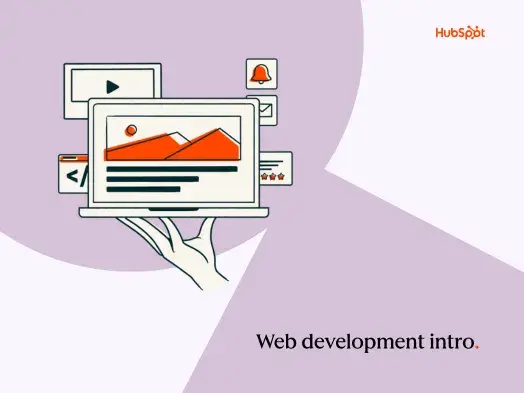For your brand to prosper, you must have an online presence — which begins with a website. But how long does it take to build a website? And what can you expect during the process from start to finish?
We’re here to help. In this article, we’ll cover the steps of the website development process and how much time each may take. We’ll also explore your options for designing and deploying your site and how they impact the overall time required.
Build your website with HubSpot's Free CMS Software
Here’s what you need to know about how long it really takes to build a functional website from scratch.
Table of Contents
- Website Development: An Overview
- Initial Communication and Goal Setting (1 - 3 weeks)
- Creating an Action Plan (1 - 2 weeks)
- Design Mockups and Feedback (2 - 3 weeks)
- In-depth Development (1 - 2 months)
- Review and Revision (1 - 2 weeks)
- DIY Website Development
- Tips for Speeding Up a Site Launch

HubSpot's Free Website Builder
Create and customize your own business website with an easy drag-and-drop website builder.
- Build a website without any coding skills.
- Pre-built themes and templates.
- Built-in marketing tools and features.
- And more!
Website Development: An Overview
While it’s possible to design and build a website in-house, most businesses opt for professional web development firms or freelancers to ensure the reliability and usability of their site.
From the outside looking in, many websites seem simple: A few menus here, a few buttons there, some links and some images, and you’re done, right?
Not quite. In actuality, there’s a lot going on underneath the user interface presented to staff and customers — everything from HTML and CSS to PHP, Java, and other programming languages needed to deliver the ideal result.
In practice, the process of building a website with a development firm typically encompasses six steps:
- Research and selection.
- Initial communication and goal-setting.
- Creating an action plan.
- Design mockups and feedback.
- In-depth development.
- Review and revision.
Let’s take a look at each of these steps in more detail and how long each typically takes.
Research and Selection (1 week - 1 month)
The first step in website building is selecting your developer. Depending on your needs and budget, this part of the process could take between one week and one month.
For example, if you’re a small business looking to create a simple website design that gets your message and brand online, a quick compare and contrast of several smaller website development firms may be all it takes to select one and start the process. If you own or manage a larger company, multiple management layers may be involved in the decision, which could extend this stage by several weeks.
In both cases, key considerations remain the same: You’re looking for a development firm with a solid reputation for delivering on time and on budget, and you’re also looking for one that aligns with your brand’s style and aesthetic. This second consideration is far more subjective, meaning it’s worth comparing multiple providers to see which one best matches your vision for your brand.
Initial Communication and Goal Setting (1 - 3 weeks)
Once you’ve selected a developer, the next step in the process is getting in touch and setting out basic design goals.
Here, you’ve got two choices. You can let the developer make all the decisions based on the information you provide about your brand’s vision, mission, and desired outcome. Or, come prepared with a basic idea of what you want the finished product to look like.
While giving your developer a blank slate means less work for you up-front, it also means they have to spend more time reviewing your brand and creating several proposals. If you provide a general outline, developers can hit the ground running and offer specific feedback on what works, what doesn’t, and what could be added to improve your website’s impact.
Creating an Action Plan (1 - 2 weeks)
Equipped with your expectations, developers will create several basic website plans that they’ll share with your team. You’ll review these action plans to determine if they fit your requirements or miss the mark. If they’re in line with your expectations, you’ll also suggest specific additions or revisions, which will prompt another round of plans from your developer.
Expect this step to take between one and two weeks as you communicate back and forth with your developer to determine the best course of action.
Design Mockups and Feedback (2 - 3 weeks)
Design mockups and feedback come next. Think of these mockups as a very basic version of the finished website product. Also called wireframes, these mockups provide a sense of where things like text, images, and buttons will appear on your website, along with the general scale of these elements.
You should get a mockup of every page that will be included on your website. If you’re hiring a developer to create your homepage, about us page, service pages, and product pages, you’ll want a mockup of each one.
This stage is the ideal time to provide detailed feedback. If you aren’t sure about something or don’t like where an element or image is placed, say something. Since no actual development has happened yet, changing these is easy. If you wait until the main development phase, changes are still possible, but they can significantly set back your timeline.
Expect two to three weeks of emails and mockup versions before you settle on an approved design.
In-Depth Development (1 - 2 months)
Next up is the most substantive stage of website building: in-depth development. This is where your developer takes approved mockups and turns them into a fully functioning website that includes all of the content you’ve approved.
Depending on the size and complexity of your website, this phase could take one to two months — or even longer if setbacks occur. Make no mistake: Nothing ever goes exactly as planned, but good developers will build extra time into their estimates so projects adhere to the timeline stated.
During this stage, your developer should be in regular contact, providing updates about the project and snapshots of how things are progressing. If you see something that isn’t going as planned or doesn’t look like the mockup, mention it to them. While this may add minor delays to the project, it’s better than taking your entire site offline after it goes live because the issue wasn’t addressed earlier.
One to two months is fairly standard for site building, but this could stretch to three or even four if you regularly make additions or changes.
Review and Revision (1 - 2 weeks)
Once your website has been designed, tested, and optimized, your developer will send it to your team for review and revision. In this stage, you’ll evaluate the final product and ensure that it looks and performs as expected.
If previous stages have gone to plan, only minor corrections will be needed — small issues such as font size or color choice can be easily rectified before your site goes live. Expect this to take between one and two weeks as your team reviews the site and identifies any issues.
Worth noting? Website design and development don’t end after review and revision. Weeks or months down the line, you may discover features you want to implement or updates to keep your site running smoothly. As a result, it’s a good idea to look for a developer that offers both up-front and long-term support to ensure optimal website operations.
DIY Website Development
All told, the process of designing and deploying a professionally built website could take between five and six months.
If you can’t afford to wait that long — or if you don’t have the budget to hire a professional website design firm — you can opt for do-it-yourself (DIY) website development. Here, tools like Content Hub can help you quickly build and optimize new websites, along with flexible themes that let you easily create and connect pages for a seamless experience.
Using a DIY tool can significantly cut your website design costs and time to launch. Instead of months, your website can be ready to go in a matter of weeks.
Pros and Cons of DIY Website Development
Unsure whether to go the professional or DIY route with your website? Here are the pros and cons of both professional development and DIY website builds.
Professional Development
Pros:
- Expert developers can completely customize your website
- Sites are fully tested and optimized before release
- All revisions and changes are handled by your developer
Cons:
- More costly than DIY solutions
- Five- to six-month timeline between start and finish
- Requires continual communication to ensure consistency
DIY Development
Pros:
- Faster than professional development at one to two weeks
- Less costly — many website development tools are free or very low-cost
- All data and corporate assets stay in-house
Cons:
- Limited amount of customization options
- Requires teams to focus on site-building over other projects
- Ongoing maintenance and support must be handled in-house
Tips for Speeding Up a Site Launch
-1.webp?width=650&height=433&name=emailmarketing_3%20(2)-1.webp)
Use automated tools and services.
Automation tools can make it easier to create and deploy websites quickly. Technologies such as Content Hub, WordPress, or other content management systems (CMS) can be used to streamline the development process. By using automated tools and services, you'll save time on tasks like creating new pages, uploading content, and other mundane website-related tasks.
Optimize your website for performance.
Slow loading times can create a poor user experience and can even affect your SEO ranking. To ensure the speed of your website, you should optimize it for performance. This includes reducing image sizes where possible, minimizing external scripts or plugins, and using caching services.
Get support from experts.
If you don't have the resources to build a website yourself, consider getting help from experts who can handle the development process for you. Look for developers who specialize in the technology and platform your site is built on so that they can provide assistance as quickly as possible. Having a team of experienced professionals working on your website can help speed up the process and ensure that your site is built correctly.
Prioritize your features.
When building a website, it‘s important to prioritize which features you need. This will help you focus on the core components of the website and avoid wasting time on unnecessary features that may not be used as often. It also allows you to launch the website sooner since you’re not bogged down with additional features that can take longer to implement.
Conduct regular reviews.
Performing regular reviews of your website’s progress is one of the best ways to ensure it stays on track and launches quickly. Establishing a schedule for reviews allows both you and your development team to review the current progress and make sure everything is running smoothly. This also allows you to identify any potential issues early on, which can help keep the project timeline on track.
Create a backup plan.
Finally, it’s important to create a backup plan in case something goes wrong during development. Consider creating backups of your website data and code in case they need to be restored in the future. It’s also a good idea to have access to a backup server in case your current website hosting fails. This will ensure that you can restore your site quickly if any issues arise during development.
These tips should help you speed up the website launch process and get your site online faster than ever before.
Take the Time to Get It Right
No matter which approach you choose, it’s time to make sure you’ve got a reliable and responsive website that reflects your brand and makes it easy for potential buyers to find what they’re looking for. Using resources such as Hubspot's free DNB builder may prove quite beneficial in your site-building journey.
If you opt for DIY tools, expect your build to be more cost-effective and less time-consuming, but recognize that you’ll be limited by specific templates and frameworks.
If you choose professional development, meanwhile, anticipate a timeline of five to six months and greater expense, but with total control over the creation and content of your site.
Editor's note: This post was originally published in September 2021 and has been updated for comprehensiveness.
Website Development





![How to make a website with user accounts and profiles [with WordPress, Wix, and more]](https://53.fs1.hubspotusercontent-na1.net/hubfs/53/%5BUse%20(3).webp)
![How to build a Google Site that looks good and drives business [templates & examples]](https://53.fs1.hubspotusercontent-na1.net/hubfs/53/Website%20Redesign%20Terms.png)





